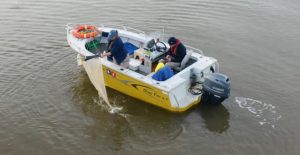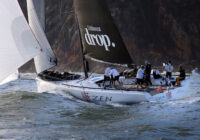How much microplastic is in your local waterway?
Which estuaries have the highest levels of microplastic contamination? What are the main sources of microplastics in New South Wales?
These are the questions DCCEEW researchers are determined to answer as they undertake a broadscale microplastics survey of 120 NSW estuaries.

In 2022 the statewide Marine Debris Threat and Risk Assessment identified microplastics as a priority threat to our waterways.
“Microplastics are an insidious problem, they are really hard to get out of the environment. We find them everywhere, in all corners of the world. They are in our bloodstream and in the food that we eat,” EPA Programs Manager, Rupert Saville said.
Sam Lynch, Coastal and Marine Scientist at DCCEEW, said the project aims to develop a deeper understanding of microplastics through a broad-scale statewide assessment.
“Of the waterways we’ve assessed, 10% of those estuaries have what we call nurdles, also known as plastic feedstock, which is what plastic manufacturers use to develop plastic items,” she said.
Taking inspiration from nature, the team use a specially designed net trawled behind a boat or canoe.
“If you think about how a mantra ray or whale shark feeds, the net acts in a very similar way, capturing microplastics from the top 15 cm of the water surface,” Ms Lynch said.
The samples are taken back to the laboratory where plastic is extracted, dyed and photographed. A computer then analyses the photo to count microplastics and determines the pollution rating. Each polymer type is identified using a Fourier Transform Infrared Spectroscopy machine.
This process allows the team to understand the density of microplastic in each estuary.
“So, we can not only see where the estuaries most affected by microplastics are in the state, but also what are the most polluting microplastic items,” Ms Lynch said.
“In all our urban estuaries we are finding a lot of artificial grass. We are also finding a high percentage of polystyrene.”
Mr Saville said in addition to identifying density per location and type of plastic, in some cases the research will help trace it back to the source.
“It allows us to understand where they are coming from, which catchments, in some cases which Local Government Areas and in certain cases, which factories.”
“Then we’re able to work with our partners in ‘Operation Clean Sweep’, who then work with councils and industries to really target these items at the source and stop them escaping into the environment in the first place,” he said.
The results will provide detailed insights into microplastic pollution.
“By the end of 2025, we will be able to tell you what the density of microplastic is for the 120 waterways we assessed. There will be a grade for each estuary assessed of high, medium or low and there will be interactive heat maps for microplastic presence and abundance across the 120 estuaries surveyed,” Ms Lynch said.
For more information on the study’s methodology and the estuaries surveyed, visit the EPA website.
The study is undertaken by the Coastal and Marine Science team in the Department of Climate Change, Energy, the Environment and Water, funded by the NSW Environment Protection Authority.
It was designed to fill knowledge gaps around microplastics in NSW. A rapid microplastic assessment method was developed as part of the Marine Estate Management Strategy. This study sits under the Marine debris research and management program.







